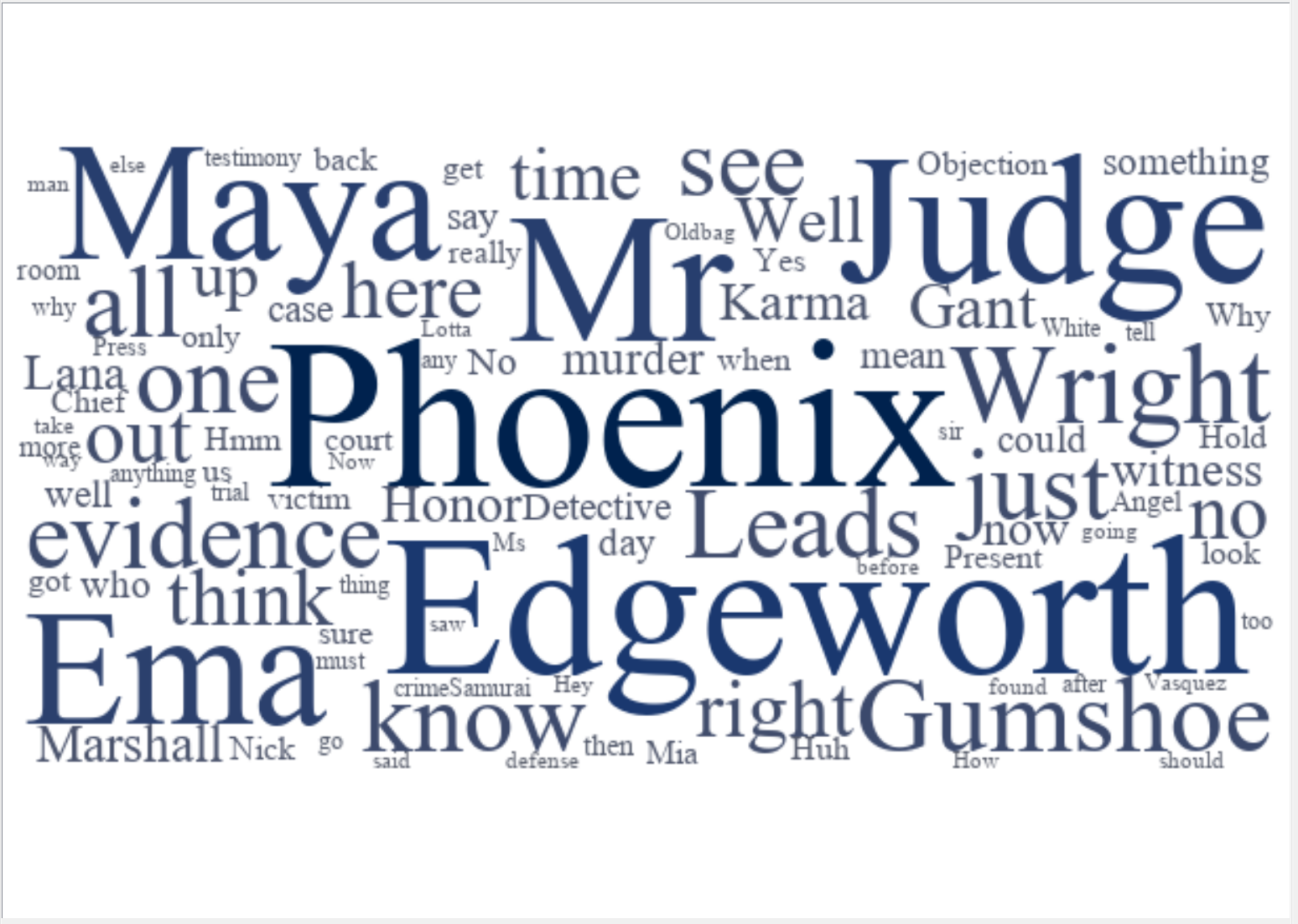Analysis

This page contains analysis of data pertaining to the Ace Attorney franchise.
For more info on how exactly we acrued our data, check out the data page.
As a reminder, our data typically looks something like
this:
<line speaker="Phoenix">Prosecutor Blackquill! What if I told you that
the two astronauts... ...never set foot inside the launch pad area, but instead,
went into another place? And what if when the director moved Launch Pad 1 back,
it was not from the launch site... ...but from another place. What would you say
then?</line>
<line speaker="Blackquill">Cut the existential
bull or I'll cut you.</line>
<line speaker="Judge">Mr. Wright,
you will explain yourself at once!</line>
<line
speaker="Phoenix"><thought>I know I'm right. It was all the other way
around from the beginning!</thought> Very well, Your Honor. Let me
explain. Director Cosmos's reason for moving Launch Pad 1
was...</line>
<line speaker="Phoenix">Because he wanted to hide
Launch Pad 1!</line>
<line speaker="Judge">Hmm, well, let's
suppose he did move it. Where in the world would he hide it? An enormous launch
pad like that... I highly doubt it could truly be
hidden.</line>
<line speaker="Phoenix">Oh, uh... behind
something, maybe...?</line>
<line speaker="Judge">Mr. Wright!
Are you asking me or telling me?!</line>
<line
speaker="Phoenix">Urk. <thought>Looks like I messed that
up...</thought> Your Honor! Please let me give it another
try!</line>
<line speaker="Phoenix">Because he wanted to trap
the true killer!</line>
<line
speaker="Blackquill">............Hmph. Wright-dono, need I remind you there
was an explosion? And that the corridor between the launch pad and the lounge
was thick with smoke? If the killer had been trapped in there, they would've
been found as dead as their victim.</line>
<line
speaker="Phoenix">I-I guess you're right.</line>
<line
speaker="Judge">Well, I'm glad you both agree. Now here's a penalty for you,
Mr. Wright.</line>
<line speaker="Phoenix"><thought>I
don't agree with that penalty, though...</thought> Your Honor! Please give
me another chance!</line>
Ace Attorney is a visual novel, so there's a ton of text, all of it appearing as
dialogue between characters. To reflect this, out XML data contains all the
'dialogue' with the speaker outlined in an attribute. So what data can we glean from
this XML, and how exactly can we secure it?
One piece of information we wanted
to find was how many lines each speaker had. This is pretty simple to find in each
individual file, but searching over our whole collection is a bit harder. We'll use
a combination of XQuery, which lets you run XPath searches over collections of
files, and PyVis, which'll let us display the data we select as a network with nodes
and edges.
For a full breakdown on the process, and to run the code yourself,
check out this Jupyter Notebook!
After running all
that code and constructing our network, we end up with this:
Cool! With this graph, it's clear that Phoenix, Edgeworth, Ryunosuke, Apollo, and the
Judge are the most common speakers. Phoenix's position is obvious, as he's a main
character in all 6 mainline games, and it's no surprise that Apollo makes the top
cut as well, he's a protagonist in half the mainline games. It's interesting that
Ryunosuke has more lines than Apollo though, as he's the protagonist in only 2
spinoff games. A similar phenomenon occurs with Edgeworth. Those with a
passing knowledge of the series might be surprised that he's in second place when it
comes to number of lines. He's the primary antagonist in the first game, and shows
up once or twice in pretty much all the other games, but the real reason he has so
many lines is that he stars in 2 of his own spin off games, the Ace Attorney
Investigation games. It's amusing that the Judge appears here, but not surprising.
Roughly half of the Ace Attorney games' gameplay takes place in the courtroom, where
the Judge features prominently. He's never been a very defined character though, so
his relevance over more memorable characters like Athena Cykes or Maya Fey is a bit
baffling.
We can refine our graph (and make it easier to read) by adjusting
our coloring strategy and actually connecting our nodes together to form a long
string from most prominent character to least prominent.
This process was
detailed in the same notebook from earlier, so revisit it if you'd like!
Here's what our refined
graph looks like:
As an Ace Attorney fan, it was pretty fun to follow the path and find the first
character I didn't recognize right away (It was Ryutaro; see how far down on the
chain they are?). The number 75 was chosen arbitrarily, but it turned out to be
pretty effective. Near the end of the trail, the characters start becoming pretty
obscure.
There is some data analysis that can only be done using NLP, natural
language processing, to scan over our text and pick out certain types of word. In this notebook, we use XQuery to find all of the main character Phoenix's
longest lines and picks out the proper nouns used most often, but you're encouraged
to mess with the code yourself to find something different! Regardless, here's the
bar graph created from the data we picked out:

This data is pretty flawed. Those familiar with the franchise would recognize that there's no reason for the character Olga Orly to show up so prominently, she's only in ONE case! I believe this is the result of our data-sparsing technique. For brevity, we only analyzed lines above 300 characters, so I guess Phoenix was just going off about this Olga lady at one point for one reason or another. Undoubtedly, if our data-sparsing technique was refined a bit, we'd make a more accurate graph.
We don't have to stop there, another data visualization tactic we can do is to go
over each file in our corpus using XQuery and build an SVG image from the data we
gather.
The SVG graph shown below is a graph depicting the number of lines the
main character Phoenix has in each episode's transcript (made with this XQuery
file).